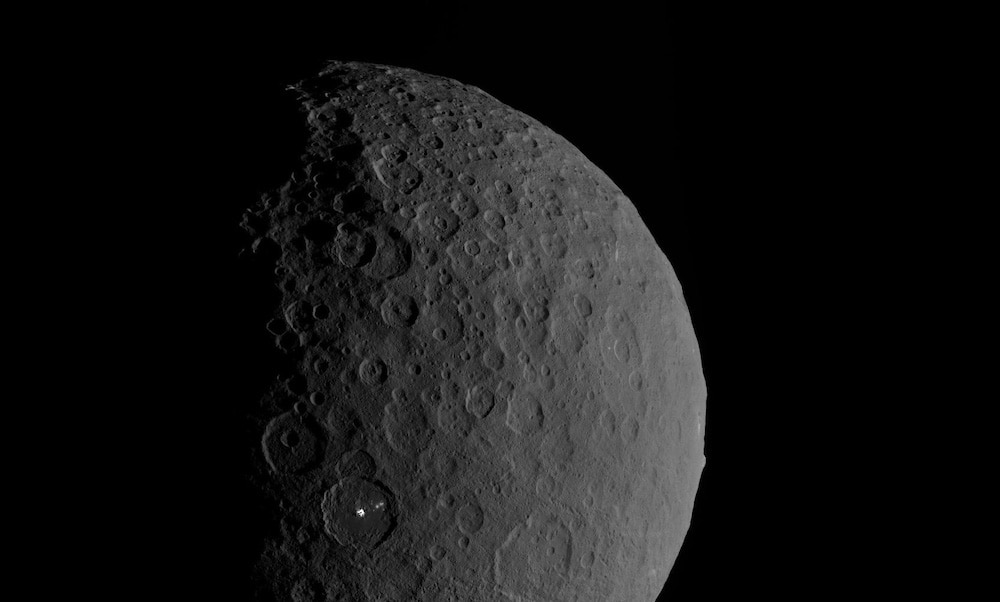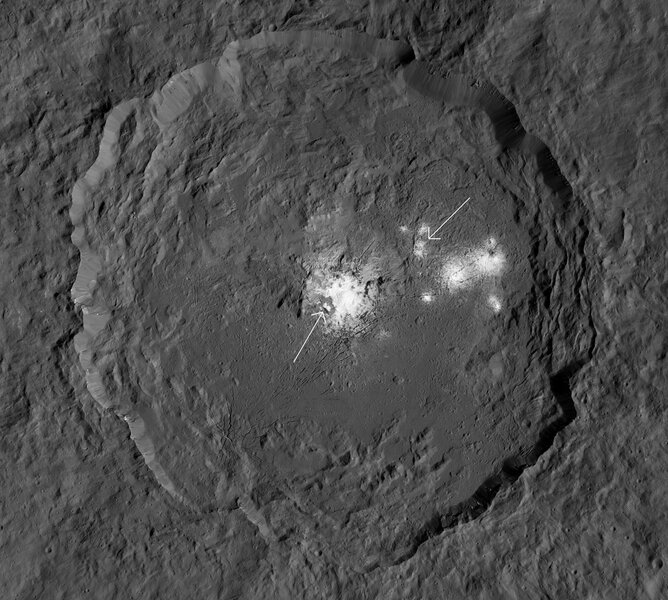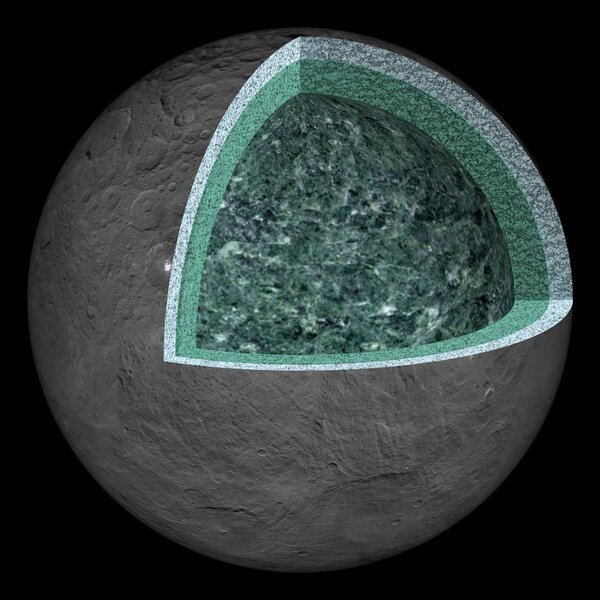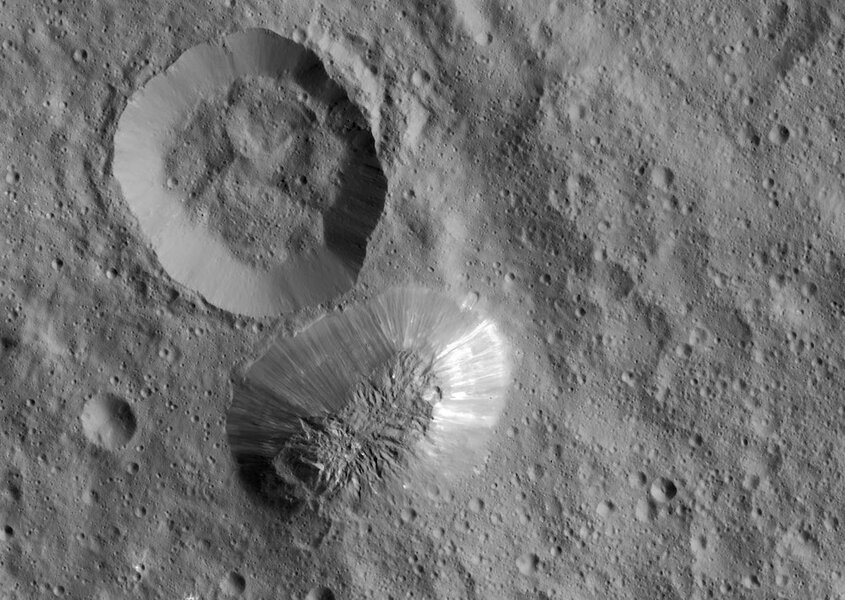Create a free profile to get unlimited access to exclusive videos, sweepstakes, and more!
Ceres may be an invader from the outer solar system
It’s the largest world in the asteroid belt, but it may not have been born there.

There are so many weird worlds in the solar system I’m starting to question what’s normal*.
Take Ceres. Discovered on January 1, 1801, it was the first object detected between Mars and Jupiter. Soon after that, a lot more were discovered — over a million main belt asteroids are now known — but Ceres is the largest. It’s so big that planetary scientists don’t call it an asteroid. Instead, it’s a protoplanet: An object that was well on its way to becoming a proper planet, but ran out of material before it could.
It’s over 900 kilometers across, and the Dawn spacecraft which went into orbit around Ceres in March 2015 revealed a rich, diverse, and spectacularly bizarre geography, with a huge lone cryovolcano, a crater with lots of bright spots that turned out to be salt left over from upwelling water — Ceres may have an undersurface ocean — and lots more.
One thing Dawn found that was a bigger surprise among many was the presence of ammonia. That is relatively rare in the main asteroid belt, because it vaporizes at temperatures typical there. Ammonia mixed in with other compounds on Ceres indicates it’s been there since the world formed, which strongly implies it formed farther out in the solar system where ammonia ice is abundant. If that’s the case, it must have somehow migrated in toward the Sun and settled in between Mars and Jupiter.
We know planets can do this — Jupiter, Saturn, Uranus, and Neptune moved inward and outward shortly after they formed — but could it also be true of Ceres?
A team of planetary scientists has published their research looking into this [link to paper], and finds that it’s certainly possible, bordering on likely.
This idea has been around a while and studied by many scientists. One way to do this is to use numerical simulations — code that uses the mathematics of gravity and planetary interactions to simulate the motions of multi-body systems like the planets — to see how Ceres-sized objects would behave. What’s new here is that they start with a population of Ceres-sized objects out past Saturn, and begin the simulations at a time over 4 billion years ago; that’s after Jupiter and Saturn formed, but while Uranus and Neptune were still growing.
It's likely that a lot of big planets, 5 or so times the mass of the Earth, formed in the outer solar system and migrated inward, but couldn't get past Jupiter and Saturn. When enough of them built up at that distance they started colliding, generating a lot of debris. In the end, two or three giant planets formed past Saturn, including Uranus and Neptune; a third may have formed and been ejected by interactions with Jupiter.
Other work indicates that around this time there may have been as many as 3,600 Ceres-sized icy/rocky bodies past Saturn, so the new work starts with this many. There was also still a disk of gas orbiting the Sun at this distance at that time, and the Ceresoids (I just made that up, and saying it out loud I realize it’s unlikely to become a thing; in the paper they call them “Ceres candidates,” which is more accurate but less fun) would interact with that, which would help them fall in toward the Sun. There’s drag from the bodies moving through the gas, but they would also leave a wake behind them, and that wake gravitationally torques the Ceresoids. All of this would help them move inward.
After running the sims, the scientists found that most of the objects are lost; ejected, or crashed into planets. But a small fraction survives, from 0.003% to 0.1%, depending on where the body started out in the solar system. That’s a tiny percentage, but remember we’re starting with 3,600 objects. After many runs, they found that the simulations showed that 70% of the objects that wound up in the asteroid belt had orbit sizes similar to that of Ceres, 33% had fairly circular orbits similar to that of Ceres, and 45% had a low tilt, less than 10°, also similar to that of Ceres.
At some point after the gas giants formed, the giant planets started moving around due to their gravitation interactions. This wreaked havoc on the main asteroid belt, and gravitational perturbations probably cleared 80-90% of all objects in the main belt. When they account for that and all the other objects lost, they find that their simulations predict… about one Ceres-like object would remain.
Well, that’s convenient. That’s how many we have! The next largest rock out there is Vesta, also a protoplanet, but it’s only about half the diameter of Ceres. So it seems the simulations get an answer that’s about right.
As usual, though, I’ll caution that getting the right answer doesn’t mean a simulation is actually right. There could be other factors that wind up being important that the sims don’t include, for example. Note too that I wrote that “about one” is left. Some runs would have more, some none. So this result is right in the statistical sense. But that’s OK, because that does match reality, so that means in a general sense they appear to be doing this right. They note that any simulation is “a simplified and idealized version of reality,” and go on to list where their work is limited, so that’s cool. It’s important in science to note where things could be done better in the future.
We used to think that all the stuff in the solar system pretty much formed where we see them today. We now know that’s really, really not true. Ceres is just one example of this, the outer planets another. That movement is complex and subtle. Even now the orbits of the planets aren’t engraved in space, and over long epochs of time, like billions of years, they’ll change as well. But we can use our understanding of gravity to predict this, and even postdict it to see where things were when the solar system was young.
I wonder what other surprises await us as we run the virtual clock of our solar system backwards. Ceres may just be the first of many worlds that started off very different than they are now.
* To be fair, I started questioning that a long time ago.





























